The world of broadcasting in the Northeastern US and eastern
Canada looks awfully small at the end of this year, doesn't it?
But for that one terrible morning in September, our year-end
review would suggest that this was an uneventful year in our
region -- and in most ways, it was. The consolidation wave that
began a decade ago finally petered out as the big groups ran
out of stations to buy and easy money to buy them with. Too many
good programmers and managers found themselves out of work as
the economy turned, and there wasn't much new or creative to
be found from the overworked employees who remained at the big
groups.
LPFM was regulated into irrelevancy, while programming and
political conflicts hampered other players on the noncommercial
side. And while one satellite radio operator launched, there
were serious questions about that nascent industry's ability
to keep raising money over the long term.
Then came September 11. Even as broadcasters mourned the loss
of six of their own, not to mention one of the nation's most
important transmitter sites, the industry rediscovered its purpose,
tying America and the world together in a manner unseen since
another terrible day in Dallas almost forty years ago. From the
biggest of clusters to the smallest of stand-alone operators,
radio and television came together to truly, however briefly,
serve the public interest, convenience and necessity. FM stations
discovered news mattered; groups everywhere raised money and
supplies; and after six days of non-stop news coverage, David
Letterman showed he was more than just a comedian (and Dan Rather
showed he was either more sensitive than anyone knew, or perhaps
just very, very tired!)
We'll come back to that. First, though, our traditional rundown
of The Year in Sales...
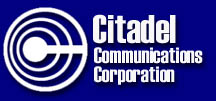 January: With Wall Street's easy
money drying up, private ownership was looking better to the
big groups. Citadel went private to the tune of $2 billion, in
the arms of the Forstmann, Little investment group.
January: With Wall Street's easy
money drying up, private ownership was looking better to the
big groups. Citadel went private to the tune of $2 billion, in
the arms of the Forstmann, Little investment group.
Two other big groups grew on the Boston AM dial, as Salem
paid $11 million for Carter's WROL and Clear Channel closed out
the Fairbanks era with a $10 million purchase of WKOX.
To the west, Saga paid the Haigis family $2.2 million for
WHAI in Greenfield (flipping the AM to a WHMP simulcast as WHMQ),
while Pamal added to its central Vermont holdings with a $1.65
million purchase of WEBK in Killington. Stephen King's Zone Group
paid $165,000 for WDME-FM in Dover-Foxcroft, Maine, while Mariner
paid Scott Hogg "a whole bunch of quarters" for Bar
Harbor's WMDI.
February: Just three sales, none of them big,
as Sheridan added Pittsburgh's WPGR from Mortenson for $625,000,
Ken Roser added WBGK Newport Village, NY to his Bug Country roster
for $575,000 and WIEZ, WMRF and WLAK in Lewistown, PA changed
hands from Mifflin County Broadcasting to First Media.
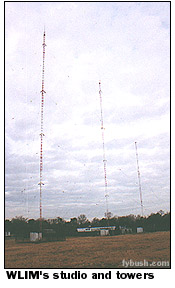 March: Charlie
Banta's Millennium kicked off a big year with the $19.4 million
purchase of Citadel's Atlantic City cluster. Out on Long Island,
Jack Ellsworth sold WLIM to Polnet for $850,000, while in New
England, Eastern Media sold WESO Southbridge, MA to Money Matters
Radiofor $250,000 and Michael Gerardi sold WINY Putnam, CT to
the station's morning man, Gary Osbrey, for $2 million. Up in
Canada, Redmond Broadcasting paid C$1.05 million for CHCD-FM
in Simcoe, Ontario.
March: Charlie
Banta's Millennium kicked off a big year with the $19.4 million
purchase of Citadel's Atlantic City cluster. Out on Long Island,
Jack Ellsworth sold WLIM to Polnet for $850,000, while in New
England, Eastern Media sold WESO Southbridge, MA to Money Matters
Radiofor $250,000 and Michael Gerardi sold WINY Putnam, CT to
the station's morning man, Gary Osbrey, for $2 million. Up in
Canada, Redmond Broadcasting paid C$1.05 million for CHCD-FM
in Simcoe, Ontario.
April: A busy month, led off by Clear Channel's
addition of Gopher Hill's WABI and WWBX in Bangor, for $3.75
million. Disney paid $3 million for AAA's WICE in Pawtucket,
moving Radio Disney down the dial from 1450 to 550 in the Providence
market. (Disney then unloaded 1450, West Warwick's WHRC, to Hall
for $410,000.) "K Licensee," the Korean broadcaster
that runs New York's WZRC, added a Long Island outlet, Barnstable's
WGSM, for $2.5 million, while Educational Media Foundation put
Utica on the "K-Love" map by paying Nelson Suggs $1.25
million for WVVC. Vox paid Alex McEwing $1.075 million for WWOD
in the White River Junction market.
In the sub-million category, Mortenson bowed out of Pittsburgh
with a $900,000 sale of WWNL to Wilkins, while D&E Broadcasting
shelled out $300,000 to pick up WPAO and WRTK in the Youngstown,
Ohio market. Five Towns College paid Barnstable $72,000 for WFOG
on Long Island's East End, while Kevin Fitzgerald added WRPA
in Laporte, PA to his station roster in the Twin Tiers.
May: Calvary Satellite Network paid DuBois Area
Broadcasters $300,000 for WREQ in Ridgebury, PA, while Ed Levine's
Galaxy Communications bought WSCP AM-FM in Sandy Creek-Pulaski,
NY from Tri-City Broadcasting for $400,000. Those deals were
dwarfed up north, though, by Astral's C$255 million buyout of
the Telemedia group in Quebec and the Maritimes.
June: Facing health problems, Keating Willcox
sold all his New England stations, except WNSH in Beverly, MA,
to Ernie Anastos for $2.1 million. Candido Carrelo sold WDJZ
in Bridgeport, CT to Peoples Broadcasting Network for $425,000,
while Steve Silberberg added WFAD in Middlebury, VT to his group
with a $180,000 purchase from Kathryn Messner. Down in Pennsylvania,
New Millennium Communications picked up WSKE in Everett from
Radio Everett for $300,000, while Rochester program director
Bobby Hatfield, aka Joe Reilly, picked up dark WCNR (later renamed
WHLM) in Bloomsburg for $45,000.
 July: All
the news came from Canada, where Telemedia sold its Ontario station
group to Standard, Quebecor bought the TVA network (forcing a
spin-off of the smaller TQS network) and WIC spun Montreal's
CFCF-TV to CTV itself for C$121.5 million.
July: All
the news came from Canada, where Telemedia sold its Ontario station
group to Standard, Quebecor bought the TVA network (forcing a
spin-off of the smaller TQS network) and WIC spun Montreal's
CFCF-TV to CTV itself for C$121.5 million.
August: Not quite a sale, but ABC made headlines
by leasing New York's WEVD from the Forward Association, with
an option to buy for $78 million. Tele-Media bowed out of Albany,
selling WCPT and WKBE to Pamal and WABY/WKLI to Galaxy, for $3.5
million from each party. An hour to the south, Clear Channel
bought out Concord Media's Hudson/Catskill cluster for $4.3 million.
Down in Pennsylvania, Clear Channel paid $800,000 for WISL in
Shamokin, while in Connecticut, Tribune turned its LMA of WTXX-TV
into a purchase from Counterpoint.
September: Before the 11th put a damper on station
sales, First Media bought WCED/WMOU in DuBois, PA from Vox for
$4.2 million, while Albert Dame added WBUS in Boalsburg to his
central Pennsylvania cluster not too far away. Up in Massachusetts,
Boston's Catholic archdiocese pulled out of its planned $1.5
million purchase of WCCM Lawrence, while Clear Channel turned
its LMA of WDLC/WTSX in Port Jervis, NY into a $3 million purchase
agreement.
North of the border, Standard spun off C$100 million worth
of the former Telemedia stations to Rogers, leaving only the
Toronto portion of the Telemedia group in Standard hands. Over
in Quebec, C$74 million was the price tag on Bell Globemedia's
purchase of TQS from Quebecor.
October: Clear Channel pulls out one more big
acquisition, paying $800 million for the Ackerley Group holdings
that include TV stations in upstate New York and California,
radio in Seattle and billboards in Boston. Galaxy added another
Albany-market signal, paying Vox $2.4 million for the soon-to-be-moved
WHTR. Clear Channel added more to its Central Maine cluster,
paying Mountain Wireless $1.8 million for Skowhegan's WSKW and
WHQO.
On the smaller side, $165,000 was the sale price for WVZN
in Columbia, PA, changing hands from the Susquehanna Association
for the Blind and Visually Impaired to Esfuerzo de Union Cristiana.
And while there was word that Ed Bold had sold WSNJ in Bridgeton,
NJ, no sale application made it to the FCC by year's end.
November: Cumulus made the big headlines, as
the back-from-the-near-dead group agreed to pay Aurora $230 million
for its suburban New York cluster. Vox bought WCFR-FM in Walpole,
NH from Gary Savoie (for $200,000) and sold WGAM in Greenfield,
MA back to Ed Skutnik. Robert and Shirley Wolf sold WNBX in Springfield,
VT to Bob Vinikoor for $75,000, while Steve Silberberg picked
up WLFE(AM) in Plattsburgh, NY for $150,000.
 Robert Howe donated
the struggling WBTN(AM) in Bennington, VT to Southern Vermont
College, while up north, Corus added Tri-Co's three Cornwall
stations to its Ontario roster and Haliburton paid C$2.025 million
for CKLP in Parry Sound, selling CHNO in Sudbury to Newcap at
the same time.
Robert Howe donated
the struggling WBTN(AM) in Bennington, VT to Southern Vermont
College, while up north, Corus added Tri-Co's three Cornwall
stations to its Ontario roster and Haliburton paid C$2.025 million
for CKLP in Parry Sound, selling CHNO in Sudbury to Newcap at
the same time.
December: Nassau and Multicultural swapped stations
in Pennsylvania and New Jersey, with Nassau getting WVPO/WSBG
Stroudsburg and WJHR Flemington and Multicultural picking up
WTTM and WHWH in Princeton. Disney paid Regent $2 million to
bring Radio Disney to Albany by way of WGNA(AM), while Broadcast
Communications Inc. paid $850,000 for WANB AM-FM in Waynesburg,
PA. Up in Canada, Maritime Broadcasting Systems applied to add
CJRW-FM in Summerside, P.E.I. to its large roster of stations
in the region.
Exciting formats? Not on the commercial dials this year! Rhythmic
oldies continued its slow death, urban made a few key gains,
and Radio Disney added two new markets and improved one signal.
Public radio tried to balance the needs of classical music
listeners and news/talk fans, while in the commercial talk world
it was a good year for Opie and Anthony and a lousy one for Laura
Schlessinger and Rush Limbaugh. The laughter ended for comedy
radio when Comedy World went under.
All the format tweaking by terrestrial broadcasters was shown
up by 100 new channels from XM at year's end, while back down
on earth, it seemed like everyone had flipped to an all-Christmas
format. Let's take it month by month, then, in The Year in
Formats, Calls and People:
January: No midnight format
changes on New Year's Day this year, but things soon got moving
in New England, as Springfield-market WNNZ (640) segued from
talk to sports, Boston-market WMEX (1060) dumped talk for business
news as WBIX (Jan. 8) and Worcester's WCRN replaced religion
with swing music.
In Canada, January 8 brought the return of AM 740 in Toronto
as "Prime Time Radio" CHWO and the debut of Conestoga
College's CJIQ (88.3 Waterloo), not to mention a format change
from classical to all-jazz at Toronto's CJRT.
Up in Maine, WBYA (101.7 Searsport) became classic rock "Fox"
WFZX, while WHQO in Skowhegan got down as "Party 108."
New Hampshire oldies outlet WZEN grabbed the WMEX calls from
Boston.
 Upstate New York heard oldies
"Wheels" WHTR move from 107.1 to 93.5 in Glens Falls,
with 107.1 becoming country "Froggy" WFFG-FM and country
WZZM-FM disappearing from 93.5. In Poughkeepsie, the new "Kiss"
stations got new "Kiss" calls - WPKF on 96.1 Poughkeepsie,
ex-WTND, and WFKP on 99.3 Ellenville, ex-WTHN. "Sunny"
in Syracuse became WZUN, ex-WRDS. Up in Watertown, WUZZ 1410
flirted with the WGME calls, then went sports as WNER.
Upstate New York heard oldies
"Wheels" WHTR move from 107.1 to 93.5 in Glens Falls,
with 107.1 becoming country "Froggy" WFFG-FM and country
WZZM-FM disappearing from 93.5. In Poughkeepsie, the new "Kiss"
stations got new "Kiss" calls - WPKF on 96.1 Poughkeepsie,
ex-WTND, and WFKP on 99.3 Ellenville, ex-WTHN. "Sunny"
in Syracuse became WZUN, ex-WRDS. Up in Watertown, WUZZ 1410
flirted with the WGME calls, then went sports as WNER.
Pennsylvania saw WHLM (106.5 Bloomsburg) become WFYY, "Flyte;"
WSRA in Central City become WCCL, with oldies for Johnstown and
WMDE in Saegertown become WHUZ, "Wuzz" classic hits
for Meadville.
Up in Canada, Brockville's CHXL became CJPT, "the Point."
 Down in New York
City, WBAI was embroiled in the Pacifica political debate, with
staffers seizing control of the station's Web site to protest
PD Bernard White's ouster.
Down in New York
City, WBAI was embroiled in the Pacifica political debate, with
staffers seizing control of the station's Web site to protest
PD Bernard White's ouster.
In New Hampshire, the statewide public radio service faced
some static over a new schedule that replaced several weekday
music shows with NPR talk, and in Toronto, CHUM announced AM
1050 would drop the oldies for sports later in the year, ending
a four-decade legacy of music radio there. "Survivor"
Richard Hatch joined Charlie Wilde on the morning show at Boston's
WQSX, and who'd have thought Hatch would outlast Wilde in that
seat?
 On TV, Connecticut
viewers switched to WTXX for WB programs, while former WB affiliate
WBNE became UPN outlet WCTX on channel 59.
On TV, Connecticut
viewers switched to WTXX for WB programs, while former WB affiliate
WBNE became UPN outlet WCTX on channel 59.
New to the air: WLPL in Walpole, NH, simulcasting WWOD up
the river; WNLO-TV in Buffalo, replacing noncommercial WNEQ on
channel 23 on January 29; and, briefly, WXXC in Truxton, NY,
the never-quite-authorized southern outlet of Syracuse Commercial
Radio.
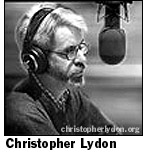 February:
The month began with a frequency swap in the Pioneer Valley,
with WRSI moving to 93.9 and WPVQ (as "the Bear") to
95.3. WRSI added 101.5 Marlboro VT as a simulcast, flipping its
calls from WSSH to WRSY.
February:
The month began with a frequency swap in the Pioneer Valley,
with WRSI moving to 93.9 and WPVQ (as "the Bear") to
95.3. WRSI added 101.5 Marlboro VT as a simulcast, flipping its
calls from WSSH to WRSY.
In Boston, independent WHUB-TV ended its short run, reverting
to home shopping, but the big news came on the radio dial, where
Christopher Lydon and his Connection staff departed WBUR in a
noisy public battle about who should profit from national syndication
of the erudite talk show.
Far fewer people noticed the call change at Sporting News
Radio's 1510, which flipped from WNRB to WSZE in a bid to keep
that frequency the leader in the "most call letters ever"
race in Beantown.
Up north, J.J. Jeffrey flipped WLOB to talk, while former
sister WLLB in Rumford went to religion, simulcasting WKTQ South
Paris and taking the WTME calls from 1240 in Lewiston, which
then dropped the WTME calls to become Headline News relay WCNM.
Down East, WNSX in Winter Harbor began simulcasting classic rock
WFZX, "the Fox." Meanwhile in Connecticut, Buckley's
WDRC network segued from standards to "The Best of Everything."
 Buffalo lost "Dancin'
Oldies" on WBUF February 22, in favor of hard rock and Howard
Stern. In Rochester, "Cool" jammin' oldies heated up
to 80s pop "Channel 107.3" on Clear Channel afterthought
WLCL, only to flip back in September, while across the mall at
Entercom, former WBEE morning guy Bill Coffey returned to the
airwaves through the magic of ISDN from Philadelphia. In Syracuse,
urban WHCD finally got new calls, WPHR, to match its "Power"
slogan. Out in Schenectady, WVKZ was reborn as standards "Sun"
radio.
Buffalo lost "Dancin'
Oldies" on WBUF February 22, in favor of hard rock and Howard
Stern. In Rochester, "Cool" jammin' oldies heated up
to 80s pop "Channel 107.3" on Clear Channel afterthought
WLCL, only to flip back in September, while across the mall at
Entercom, former WBEE morning guy Bill Coffey returned to the
airwaves through the magic of ISDN from Philadelphia. In Syracuse,
urban WHCD finally got new calls, WPHR, to match its "Power"
slogan. Out in Schenectady, WVKZ was reborn as standards "Sun"
radio.
And down in the Big Apple, the WBAI disaster just kept getting
messier, as "Democracy Now!" co-host Juan Gonzalez
attacked the board of directors on the air before being removed
from the station.
Pennsylvania had new calls in Hazleton, where WILP 1300 became
WOGY, and in DuBois, where WOWQ became WMOU, plus a new format
in Pittsburgh, where WWCS flipped from R&B oldies to Radio
Disney.
On the Canadian TV dial, CHCH in Hamilton turned off "OnTV"
and became "CH" on February 5; on the radio side, CKGE
Oshawa joined the Corus "Energy" simulcast.
 New to the air: Toronto's
urban CFXJ, "Flow 93.5," on Feb. 9; CHWV (98.1) in
Saint John, N.B. on the 19th; and tests from CKMB 107.5 in Barrie
and CIKR 105.7 in Kingston.
New to the air: Toronto's
urban CFXJ, "Flow 93.5," on Feb. 9; CHWV (98.1) in
Saint John, N.B. on the 19th; and tests from CKMB 107.5 in Barrie
and CIKR 105.7 in Kingston.
March: Another defection from the sagging rhythmic
oldies format made hip-hop fans in Connecticut happy, as WZMX
became "Hot 93.7" March 16.
The 80s format picked up two new converts, with WBKX Fredonia
NY and the "Z100" WZRA/WZRI simulcast in Rhode Island
flipping from country and classic hits, respectively.
 Out on Cape Cod, a new management
team at Boch Broadcasting flipped WYST to alternative WDVT on
93.5 and WWKJ to hot AC WTWV on 101.1.
Out on Cape Cod, a new management
team at Boch Broadcasting flipped WYST to alternative WDVT on
93.5 and WWKJ to hot AC WTWV on 101.1.
While Boston's big sports station, WEEI, moved with its sister
stations from 116 Huntington Avenue to the New Balance building
in Brighton, its smaller competitor on 1510 locked up the "most
calls ever" title with another change, from WSZE to WWZN.
(Later in the year, it would also steal the Celtics away from
WEEI...)
Maine Public Radio rethought its format change, bringing back
some of the music programming that had given way to news and
talk, including weekend opera broadcasts.
Boston TV viewers followed Chet Curtis from WCVB to New England
Cable News; he'd been at Channel 5 since WCVB's 1972 debut.
AM DXers enjoyed a rare silent period on WTIC (1080) Hartford
on March 18; better yet, it was coordinated with sister station
KRLD in Dallas to give listeners a chance to hear other, more
distant 1080 signals that night.
 Something called
"Web Access Radio Live" took over WARL in Attleboro,
though it thought it was in Providence (and that the dot-com
boom wasn't over), while Chinese radio took over WNSW in the
New York market from standards "Sunny 1430." The Sporting
News outlet there changed calls, too, just so it wouldn't feel
left out: from WJWR to WSNR. Way, way upstate, WGLY (1070) in
Plattsburgh became WLFE, simulcasting the FM across the lake
in Vermont. And in the Hudson Valley, the WZCR calls replaced
WTHK on Hudson's oldies 93.5 signal.
Something called
"Web Access Radio Live" took over WARL in Attleboro,
though it thought it was in Providence (and that the dot-com
boom wasn't over), while Chinese radio took over WNSW in the
New York market from standards "Sunny 1430." The Sporting
News outlet there changed calls, too, just so it wouldn't feel
left out: from WJWR to WSNR. Way, way upstate, WGLY (1070) in
Plattsburgh became WLFE, simulcasting the FM across the lake
in Vermont. And in the Hudson Valley, the WZCR calls replaced
WTHK on Hudson's oldies 93.5 signal.
On the Jersey Shore, "Coast" WCZT moved up the dial
from 94.3 to 98.7, while the 94.3 frequency took the old WWZK
calls from 98.7 and went oldies.
 In Pennsylvania,
the Conrad garage where Westinghouse's broadcast history began
81 years ago was demolished, with hopes of rebuilding it elsewhere
someday; for now, the site is about to become a new Wendy's.
In Pennsylvania,
the Conrad garage where Westinghouse's broadcast history began
81 years ago was demolished, with hopes of rebuilding it elsewhere
someday; for now, the site is about to become a new Wendy's.
A bit north of Pittsburgh, Franklin's WFRA-FM (99.3) became
WOXX, simulcasting WXXO Cambridge Springs as CHR "Kiss"
for the Oil City-Franklin-Meadville area, while in Johnstown,
the former WJAC (850) changed calls and format again, ditching
oldies WODZ for sports as WSPO.
Canada's regulators approved AM to FM moves for CJNH Bancroft,
Ont.; CKGB Timmins, Ont.; CJCJ Woodstock, N.B. and CKCL Truro,
N.S.
New to the air: WYSI 96.1 Norwood NY, on March 16.
April: Smooth jazz and talk traded places in
Vermont, with the former sliding down the dial from WXPS (96.7)
to WJVT (92.1) in the Burlington market, while talk moved in
on 96.7 as WXZO, "the Zone," with a simulcast across
the lake on WEAV 960. The oldies that had been on 92.1 as WLCQ
disappeared in the process.
 Across the state,
Clear Channel combined country formats, simulcasting WXXK's "Kixx"
country on WMXR in Woodstock and WCFR in Springfield in place
of the "Bob" country that had been there. Later in
the year, WCFR would change calls to WXKK, sending the WCFR-FM
calls down to WLPL in Walpole; WMXR would end up as a simulcast
of WVRR on the New Hampshire side.
Across the state,
Clear Channel combined country formats, simulcasting WXXK's "Kixx"
country on WMXR in Woodstock and WCFR in Springfield in place
of the "Bob" country that had been there. Later in
the year, WCFR would change calls to WXKK, sending the WCFR-FM
calls down to WLPL in Walpole; WMXR would end up as a simulcast
of WVRR on the New Hampshire side.
In Boston, the Globe and WEEI spent a few weeks trading barbs,
with the paper barring its sportswriters from appearing on the
sports station's morning show, columnist Eileen McNamara defying
the ban, and WEEI then banning Globe writers from visiting its
airwaves. WEEI had other problems, too, as WWZN stole the Celtics
away for the 2001-2002 season.
Over at WBZ, Liz Walker announced her departure after two
decades on channel 4 amidst squabbling between the radio and
TV sides of the operation over the appearance of a channel 5
personality on WBZ's David Brudnoy talk show. (Meanwhile, WSBK
was moving in at WBZ headquarters to make the city's first TV
duopoly complete; a 7 PM newscast on WSBK would follow by year's
end.)
At channel 7, WHDH-TV, anchor Kim Carrigan was ousted in a
very public way, and being seven months pregnant didn't hurt
her standing against 'HDH in the dispute. (She would eventually
land at WBZ/WSBK to anchor the aforementioned 7 PM newscast.)
Up in Trois-Rivieres, Quebec, a small plane hit the tower
of CKTM (Channel 13), killing the pilot and forcing the demolition
of the stick. Meanwhile, the Montreal Expos began their season
without English-language radio broadcasts; they'd be off the
air until May, when CKGM stepped up to the plate for what may
yet turn out to have been the team's final season.
More format miscellany: Maine's WALZ (95.3 Machias) split
its simulcast with Calais' WQDY to go classic country in mornings,
while down the coast, WMDI in Bar Harbor went classical as WBQI.
In northern New York, WYSI (96.1 Norwood) and WVLF (96.7 Canton)
traded calls and formats. The collapse of Comedy World sent WNSS
Syracuse to a simulcast of WLTI-FM, then to all-sports, while
WFPG Atlantic City stopped laughing to simulcast its FM outlet.
Classic country came to Binghamton, as WINR (680) dropped standards
for Hank Williams and company. In Jamestown, N.Y., country WHUG-FM
became "Moo" WMHU, trading calls with an unbuilt CP
in Cooperstown, PA.
Speaking of Pennsylvania, Scranton's WARM scrapped news-talk
for oldies, while dark WRPA Laporte became WQZI and little WEBG
Loretto became WBZV as talker "Buzz."
Out on the Jersey Shore, the WUSS calls returned to Atlantic
City's 1490, which sent its old WGYM calls inland to the former
WONZ 1580.
And here in Rochester, plans for a new DTV tower on Pinnacle
Hill sparked plenty of protest at a town board meeting - and
no applause for your editor's views, inaccurately characterized
by many as "pro-tower."
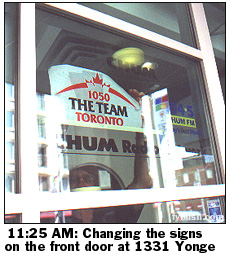 May:
It was the end of an era in Toronto, as your editor joined the
party to mark the demise of oldies on CHUM (1050), replaced by
sports on the afternoon of May 7.
May:
It was the end of an era in Toronto, as your editor joined the
party to mark the demise of oldies on CHUM (1050), replaced by
sports on the afternoon of May 7.
"The Team" launched on CHUM Group stations across
Canada, including CJCH Halifax, CKGM Montreal, CKLC Kingston,
CKPT Peterborough and CKKW Kitchener.
Elsewhere in Canada, CHYR Leamington switched from country
to light rock, while CJAN Asbestos QC was granted a move to FM.
In Maine, standards on WLAM became news-talk on WMTW, with
the WLAM calls returning to their old home on 1470 in Lewiston,
ex-WZOU.
Over at Colby College, WMHB finally received a license on
its new home at 89.3, after losing its old 90.5 spot for failing
to renew its old license there.
The vacant morning co-host slot on Boston's WRKO was finally
filled by FM jock John Osterlind, four months after the untimely
death of Andy Moes left Peter Blute flying solo.
Down in Rhode Island, the Radio Disney move turned WICE into
WDDZ, while former Mouse house WHRC became WWRI, simulcasting
R&B classics with WNBH over in New Bedford.
The arrival of an urban FM in Hartford spelled the end of
"Jamz 910" in Hartford, as WNEZ took on the Spanish
music format and WLAT calls that had been on 1230 in Manchester,
leaving that signal to become WNEZ, simulcasting Spanish news
from WNNY in New York. (That station, meanwhile, would trade
expensive news hours for cheaper talk and infomercials later
in the year.)
 In New York, "Kiss"
changed Utica homes from 102.5 to the former "Wow"
simulcast on 105.5 and 97.9 (with the former becoming WSKU and
the latter taking the old WSKS calls from 102.5), while 102.5
went country as "Bob" WRBY.
In New York, "Kiss"
changed Utica homes from 102.5 to the former "Wow"
simulcast on 105.5 and 97.9 (with the former becoming WSKU and
the latter taking the old WSKS calls from 102.5), while 102.5
went country as "Bob" WRBY.
Out on the East End of Long Island, a chain of changes at
AAA's stations took soft AC WBAZ from 101.7 to 102.5, CHR WBEA
from 104.7 to 101.7, and installed a new classic rock format
(with studios at the Mohegan Sun casino in Connecticut) on 104.7
as WMOS. The old WBSQ calls and AC format from 102.5 were history,
while the WCSO calls that briefly inhabited 104.7 moved to a
new 92.9 CP that hadn't signed on at year's end. Meanwhile, the
standards breathed their last at WLIM (1580 Patchogue); the station
went Polish and longtime owner Jack Ellsworth moved down the
dial to WALK (1370).
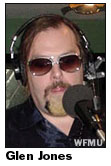 On the air in New
York City, John R. Gambling returned to weekdays at WABC, while
Glen Jones stayed on the air for over 73 hours at WFMU. And Jim
Kerr was left without a radio home when the "Y107"
quadcast declined to renew the veteran jock's contract.
On the air in New
York City, John R. Gambling returned to weekdays at WABC, while
Glen Jones stayed on the air for over 73 hours at WFMU. And Jim
Kerr was left without a radio home when the "Y107"
quadcast declined to renew the veteran jock's contract.
In southern New Jersey, religious WNNN (1510 Salem) became
"Faith" WFAI, while in Pennsylvania, the 80s "Buzz"
signals in Scranton got new calls: WBZH for WWFH and WUBZ for
WSHG (quickly changed to WBZJ when someone realized WUBZ was
already taken over in Phillipsburg!)
Elsewhere in the Keystone State, Easton's WEEX went from standards
to sports, while over in Somerset, country "Froggy"
WSGY became classic hits "Wuzz" WUZY, simulcasting
WUZI in Portage, and in Chambersburg, WCHA-FM became country
WIHR.
New to the air: CHTD, "98.1 the Tide," in St. Stephen,
N.B. (May 28).
June: NERW hit the road, traveling first to
Washington, then to Denver, then heading west again for a two-week
radio roadtrip around the upper Midwest. In the meantime, rhythmic
oldies died in Philadelphia, with WEJM (95.7) becoming "Mix"
WMWX. Regular oldies died in Harrisburg, as Clear Channel flipped
WWKL-FM to "Kiss" WHKF (though the format quickly reappeared,
first in Starview as WEGK became WHBO, then in Palmyra as WNCE
became WWKL. Clear Channel itself even revived the format, on
the AM dial, at WHYL Carlisle.)
Country WBBS in Syracuse gained a simulcast, as the former
WVOQ 105.1 (and before that, WVOA, WOIV, etc.) became WXBB.
In Erie, the WJET calls returned to AM 1400, which traded
its WLKK calls to FM 102.3 as that station was spun off to Regent,
which would eventually relaunch it as CHR "Q102" WQHZ.
Dick Gordon came down from Canada to take Chris Lydon's old
chair at WBUR's "Connection," while WSRO and WRCA had
their applications to improve their Boston signals approved,
though building them out would be another, much longer, matter.
Out on the Jersey Shore, WDOX's modern rock reappeared on
the former religious WJNN.
New to the air: WBGJ Sylvan Lake NY, relaying Radio Disney
from Syracuse's WOLF; CHMS 97.7 Bancroft, Ont., replacing CJNH
1240.
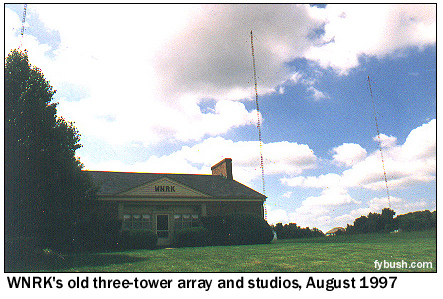
Gone, temporarily: WNRK 1260 Newark, Delaware, which lost
its tower site and went silent June 25.
July: NERW came home to find...not much. Downstate,
WFAS 1230 White Plains dropped talk for adult standards. In Liberty,
WVOS moved country from its FM signal to its AM, with the FM
going AC and the standards that had been on the AM disappearing.
Up in Maine, WHQO flipped from dance to news-talk (eventually
sending WRKD 1450 over in Rockland from news-talk to sports),
while down in Greenville, Pennsylvania, the eclectic format on
WGRP/WEXC was split off under new owners, with WGRP going "positive
country" and WEXC going religious. NERW didn't hear any
legals when we drove through a few months later; turns out the
stations were violating most of the rules in the book when the
FCC visited in November!
 In Canada, CKGB in
Timmins began testing its FM on 99.3, while CKYC 93.7 Owen Sound
made its debut.
In Canada, CKGB in
Timmins began testing its FM on 99.3, while CKYC 93.7 Owen Sound
made its debut.
More evidence that the dot-com boom was over? New York talk
outlet "eYada" fizzled out, leaving Lionel and Lori
Kramer, among others, out of work.
 August:
Despite a valiant, quixotic effort by the "Save WEVD"
folks, the left-leaning talk station ended its run on AM 1050
at month's end, replaced by ESPN Radio for the Big Apple at midnight
August 31.
August:
Despite a valiant, quixotic effort by the "Save WEVD"
folks, the left-leaning talk station ended its run on AM 1050
at month's end, replaced by ESPN Radio for the Big Apple at midnight
August 31.
On TV, Long Island public broadcaster WLIW agreed to merge
with New York's WNET. Opie and Anthony returned to Boston, using
their new perch at WBCN to mercilessly taunt - or was that "accidentally
promote" - their old home at WAAF. WWZN announced its first
local voice, adding Sean McDonough to afternoons.
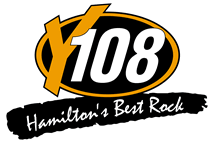 Up in Hamilton, Ont.,
CJXY's classic rock ("Y95") and CING's dance-CHR ("Energy")
traded places that day as well, with Energy getting the huge
signal at 95.3 and CJXY becoming "Y108" at 107.9, all
at 9:53 AM, of course. More Canadian news: CHUC in Cobourg was
granted a new FM at 93.3, with AM 1450 staying put.
Up in Hamilton, Ont.,
CJXY's classic rock ("Y95") and CING's dance-CHR ("Energy")
traded places that day as well, with Energy getting the huge
signal at 95.3 and CJXY becoming "Y108" at 107.9, all
at 9:53 AM, of course. More Canadian news: CHUC in Cobourg was
granted a new FM at 93.3, with AM 1450 staying put.
In Maine, standards gave way to sports at WFAU (1280 Gardiner),
simulcasting Clear Channel's WSKW (1160 Skowhegan). And in Pennsylvania,
Keymarket got ready to launch the "Pickle" with oldies
as WPKL, replacing WPQR on Uniontown's 99.3.
 September:
A TV shakeup began the month in Maine, with Portland's WPXT ditching
Fox for WB, leaving Rupert Murdoch's network to seek cable distribution
in the Pine Tree State.
September:
A TV shakeup began the month in Maine, with Portland's WPXT ditching
Fox for WB, leaving Rupert Murdoch's network to seek cable distribution
in the Pine Tree State.
On the radio side, Allentown lost oldies on FM, with WODE
going classic rock, first as the River, then as the Hawk; WKAP
grabbed the format on the AM dial. Down in Philadelphia, WEMG
moved its "Mega" Spanish format up the dial from 900
to 1310, ex-WSSJ; the WURD calls returned to 900, flipping from
silence to oldies to CNN Headline News by year's end. In Pittsburgh,
veteran KDKA morning man John Cigna announced he'd retire in
December, while across town, WPIT picked up Laura Schlessinger
after WPTT dropped her show.
Up in Vermont, WWWT Randolph ended its long FM simulcast to
go oldies via satellite.
In Maine, J.J. Jeffrey changed calls on 95.5 Topsham, from
WCLZ to WLLB-FM, freeing up the WCLZ calls to go back to 98.9
Brunswick, replacing WTPN.
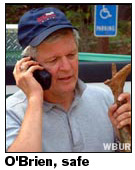 In New Hampshire,
WBUR newsman Ted O'Brien went for a short hike in the White Mountains
and didn't come out for two days, though he was fine when he
was finally found.
In New Hampshire,
WBUR newsman Ted O'Brien went for a short hike in the White Mountains
and didn't come out for two days, though he was fine when he
was finally found.
In Syracuse, WYYY morning man "Big Mike" moved across
town to WZUN.
Up in Canada, CFOB in Fort Frances, Ont. was granted a move
to 93.1 FM.
That was all before September 11, of course. Who could ever
have imagined that the World Trade Center would come tumbling
down, bringing with it the transmitters of every New York City
VHF station, two major UHF outlets and four FM stations and the
lives of six engineers, along with nearly 3,000 others?
 Yet we saw it happen,
conveyed live on station after station. Within hours, the industry
had responded in many ways. FM stations that hadn't broadcast
a news report in years were suddenly picking up network news
or simulcasting sister AM stations, and it seemed as though there
was a fund drive taking place everywhere on the dial.
Yet we saw it happen,
conveyed live on station after station. Within hours, the industry
had responded in many ways. FM stations that hadn't broadcast
a news report in years were suddenly picking up network news
or simulcasting sister AM stations, and it seemed as though there
was a fund drive taking place everywhere on the dial.
On TV, the crawl became an ubiquitous feature at the bottom
of the screen, while commercials disappeared for several days.
(The declining commercial load would take its toll later in the
year.)
Engineers went to work returning TV signals to New York, at
first through relays on surviving UHF signals from the Empire
State Building, then through temporary facilities at Alpine,
N.J., and finally through makeshift transmitters at Empire itself.
The FM signals, too, returned within days from Empire and elsewhere.
And the two stations with auxiliary sites - WCBS-TV and WKTU-FM
- seemed the most prescient of all, staying on the air throughout.
And somehow, radio went on...
October: The CRTC approved four new FM signals
for Ottawa/Hull, promising to bring multicultural radio, French
classical, urban and aboriginal programming to the dial next
year. The CRTC also approved moves to FM for CKBW in Bridgewater,
N.S. and CHVD in Dolbeau, QC, and an AM/FM trade for CJRN and
tourist information CFLZ in Niagara Falls.
Stateside, the economy forced deep staffing cuts at many big
groups, from six cuts at Entercom in Buffalo to nine at WBUR
in Boston - and more than two dozen at Clear Channel in New York,
which streamlined its management and ousted several veteran managers,
including Kid Kelly at WHTZ. On a smaller scale, Boch Broadcasting's
entire management team on Cape Cod departed less than a year
after being imported from out of town.
In Albany, Galaxy replaced "Lite 94.5" with hard
rock as "94 Rock," while Pamal replaced WCPT's "Point"
modern AC with standards as "Magic 100.9".
Pittsburgh got a new FM station, as WOGI 98.3 was approved
to move in from Charleroi to Duquesne, with a transmitter site
on the North Side.
Daniel Priestly got calls for his three Maine CPs: WNZT 1230
in Hermon; WNZS 1340 and WWNZ 1400 in Veazie.
 Over in Lewiston,
standards were replaced by news-talk at WLAM, as that station
became the third in the WMTW simulcast.
Over in Lewiston,
standards were replaced by news-talk at WLAM, as that station
became the third in the WMTW simulcast.
In Binghamton, WINR dropped classic country for an adult standards/AC
mix, while down south in Scranton, "Bear" WXBE/WXAR
dropped Stern and became "Z" rock WAOZ/WEOZ.
New to the air: WRPL 93.9, serving Erie from Fairview, and
WWPJ, the Pen Argyl, PA relay of WWFM Trenton.
November: Howard Stern lost another affiliate;
Q107's decision to drop him in Toronto left him with no Canadian
outlet. The Corus station moved to cheaper quarters in the Hard
Rock Cafe downtown, as part of budget cuts that chopped some
20 jobs in southern Ontario.
 In Kingston, N.Y.,
WBPM dropped rhythmic oldies in favor of straight oldies as "Cool,"
while down in the Trenton market, WNJO dropped oldies for classic
hits as "the Hawk" November 1.
In Kingston, N.Y.,
WBPM dropped rhythmic oldies in favor of straight oldies as "Cool,"
while down in the Trenton market, WNJO dropped oldies for classic
hits as "the Hawk" November 1.
New to the air: Maine Public Radio's WMEP (90.5 Camden), November
13.
Returning: WCAT Orange, Mass., just in time to avoid deletion,
and WNRK Newark, Del., from a temporary site on Nov. 21.
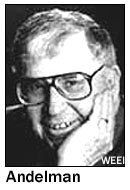 December:
CNet Radio arrived in Boston, replacing "Amor" spanish
AC on WBPS 890 December 3. The week's other big headline: Eddie
Andelman left WEEI after a decade with the sports station; he's
rumored to be talking with WWZN about moving there next year.
December:
CNet Radio arrived in Boston, replacing "Amor" spanish
AC on WBPS 890 December 3. The week's other big headline: Eddie
Andelman left WEEI after a decade with the sports station; he's
rumored to be talking with WWZN about moving there next year.
In New York City, Leslie Gold joined Bob Buchmann on the WAXQ
morning team, while GM Matt Ross was ousted at year's end as
part of the Clear Channel cutbacks in the Big Apple.
But the big shakeup came in the year's final week, as the
Yankees' YES Network announced the team would move its radio
broadcasts from WABC (770), where they've been since 1982, to
WCBS (880). The all-news station last had the Yanks from 1960
until 1966, when the team was owned by CBS. The Phillies will
move, too, in 2002, abandoning WPHT after twenty seasons in favor
of lower-powered WPEN.
 Out on Long Island,
WNYG dropped "Student Radio" for a relay of the Chinese
format of WNSW, while WFTU signed on with oldies out in Riverhead.
Out on Long Island,
WNYG dropped "Student Radio" for a relay of the Chinese
format of WNSW, while WFTU signed on with oldies out in Riverhead.
In Connecticut, hip-hop on WNTY Southington was replaced with
Fox News audio.
Up in New Hampshire, WBNC changed calls, with the FM side
becoming WVMJ and the AM becoming WXMT; no word at year's end
about format changes.
In Massachusetts, WFUB-TV decided those weren't ideal calls,
so channel 66 became WUTF before the new Telefutura network could
even debut.
In Pennsylvania, dark WLTS Mill Hall reappeared as smooth
jazz WOJZ Pleasant Gap, while the WLTS calls and AC format replaced
country WFGI on 94.5 in State College. The WFGI calls moved down
to 940 in Charleroi, sending the WPNT calls that had been there
over to 1340 in Connellsville, formerly WCVI. In Shamokin, WISL-FM
went "Bill Country," simulcasting Williamsport's WBYL,
while the AM went silent; up in Olyphant, WAAT dropped religion
for Sinatra in the mornings and talk later in the day. In Harrisburg,
Bruce Bond parted ways with longtime employer WNNK, and in Pittsburgh,
Inner City took WURP (1550 Braddock) dark.
Dozens of stations went all-Christmas, and most emerged after
the holidays with their old formats intact. But in Dexter, Maine,
WGUY (102.1) emerged from the holidays with smooth jazz instead
of oldies; down in the Portland market, meanwhile, WMTW (870
Gorham/106.7 North Windham and WLAM 1470 Lewiston) announced
that the new year would bring a change of format from talk to
all news, mostly from AP's network. Out on Cape Cod, WTWV exited
the Christmas format to become oldies; no word about a possible
call change there.
New to the air: religious WSGG (89.3 Norfolk CT), feeding
Spanish religion to an 89.7 translator in Hartford; WNEF (91.7
Newburyport MA), testing at year's end to become a relay of Boston's
WUMB.
And that, barring any changes New Year's Eve, brings us to
the end of another year...as we remember those who left us during
2001:
And we dedicate this year's Year in Review to the memory of
the six engineers who were murdered with so many others at the
World Trade Center on September 11:
If you haven't yet done so, a donation to the Ennes Educational
Foundation Trust Fund will help the families of these engineers
in their time of need. You can send it to:
*And after you've done that, you can join the many broadcasters
and radio fans who help keep NorthEast Radio Watch and fybush.com
coming to you.
These are not free services - just assembling the Year in
Review takes several days of work! - and we hope that if you
haven't yet done so, you'll visit our Support
page and send in your subscription contribution. Credit card
payment is now available for your convenience!

